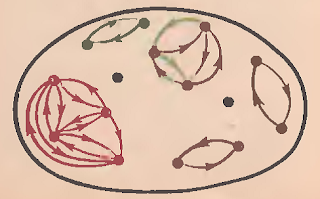Materials: geometric shapes (foam stickers)
Patterns,
Fractals, and Categories
·
Continue the
pattern.
·
Dots: red, blue, green, red, blue, green, red, blue…?
·
Dots: small, medium, big, small, medium, big, small,
medium…?
·
Square, triangle, circle, circle, square, triangle,
circle, circle, square, triangle, circle…?
For all of
these, draw them on a whiteboard, or make them out of stickers or other small
things. Don’t just say the things in the pattern! First of all, for little
kids, it’s hard to keep a lot of things in their head at a time, and also, it
gets them more involved. If the kids figure out the patterns right away (which
they did in this case), offer some harder patterns, for a challenge. An example
is, “Big square, small square, big triangle, small triangle, big circle, small
circle…”, and to make it even more challenging, the pattern can include sizes,
shapes, and colors.
·
Sort these into
groups.
·
Red big square, green big circle, red small triangle,
blue small triangle, blue small circle
Kids seemed to
be very excited that a problem can have more than one solution, and they worked
together for a while, and discussed what categories were possible. Encourage
teamwork.
·
Venn Diagrams
·
Who has a brother, a sister, or both?
·
Who likes to play (a sport that kids like), (another
sport), or both?
Kids though it was
cool that a math problem could use real life. More problems should be used that
are actually incorporating math into real life, to show the kids that math is
used in life, not just in math class. Kids also liked that for these problems,
they themselves got to decide what would be in the Venn diagram (for the
sports, they decided the sports from the Venn diagram, and for the brothers and
sisters, it was actually related to them)
·
Invent your own pattern; make it and have a partner
figure it out.
There were two
categories of what kids did: either they made an unsolvable pattern that was
random, or they made a really easy and basic pattern. The kids loved this
activity, because they actually got to create a pattern, AND, have someone
solve it!
- Discussion: where do we see patterns around us?
On this question, kids seemed to expect that I would
give them examples myself, and they needed a bit of encouragement to get them
thinking. They gave some good answers; zebras- they have stripes that are
patterns, and a spiral, that keeps spinning more and more in, and more and more
out.
·
Explain what
fractals are, and if possible, give visual illustration and pictures of them.
Kids were interested, but didn’t really care if
something was just a pattern, or a fractal.
- Finding patterns in poetry:
o
“ One fish,
o
Two fish,
o
Old fish,
o
New…?”
o
Any other poems
you can think of that have patterns? Any
songs?
These little kids aren’t old enough to know any more
poems, except the one already given to them as an example. If the teacher (or
parent) knows any more pattern poems, they could share them with the children,
but children can’t think of any themselves.
·
Continue my pattern
(sample Raven matrices)
Kids liked this
activity, and enjoyed that they had to visually figure something out as well as
mentally. These weren’t very hard for the kids, but it took them a bit of time.
Don’t help the kids as soon as they can’t solve something! Let them learn to
think and solve things on their own. Only if they are really struggling, a few
hints can be given. If the kids get enough time, they should be able to figure
it out on their own.
o
- Take turns making a pattern
out of geometric shapes (stickers)
Kids liked
working together to create a pattern. It is a good skill for the kids to be able
to create patterns, because it increases their understanding and knowledge
about patterns, and makes it easier for them to recognize one, and figure out
what the pattern is.
·
20 questions game
(on the carpet; take turns asking 20 questions to guess my object)
This is a
good cool-down activity that uses creativity and logic. Only play this game to
use as a cool-down activity! If it is played earlier than the after all the
problems have been solved, the kids wouldn’t want to go back to working!
Explore at home: http://www.shodor.org/interactivate/activities/NumberCruncher/











